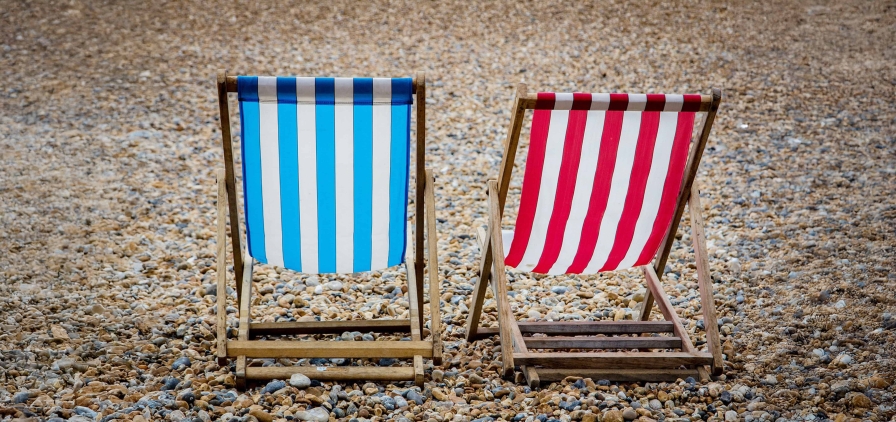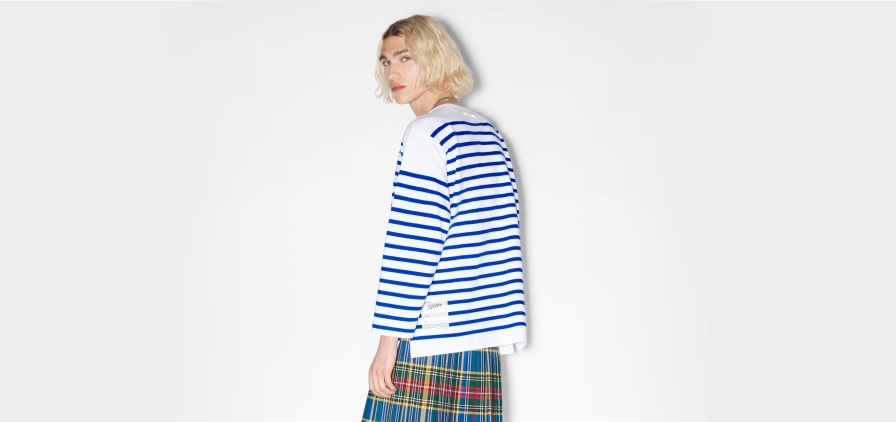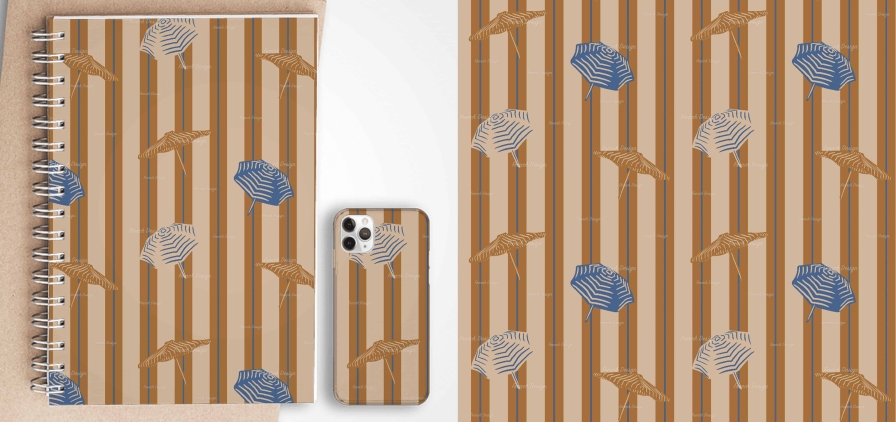
The timeless Stripe Surface Pattern
The textile stripe pattern is a timeless pattern, a great classic that spans the ages with undeniable elegance. Visually appealing, fine lines and broad stripes can easily navigate from the strictest formalism to the most unbridled fantasy. A delight for designers, always inspired by the ambivalence of this captivating textile pattern, halfway between order and disorder.
Description of the stripe pattern
Stripes come in many forms: single or multiple, in thin stripes or thick bands, horizontal, vertical, oblique... Not necessarily parallel and far from being systematically two-tone, stripes constitute a relatively protean category of patterns, organized around an essential component: the band of contrasting color.
This geometric textile pattern is equally suited to fashion and interior design, bringing a strong visual dynamic to whatever it adorns. At once a symbol of order and disorder, stripes are a blur of vision, bold enough never to go completely unnoticed, even when used as a faux-unis.
Stripes have also left their mark on ancient architecture and contemporary art, becoming in the 20th century a veritable compositional subject favored by the abstract and minimalist movements. Examples include the paintings and sculptures of Daniel Buren, whose 260 famous black-and-white columns can still be seen in the courtyard of the Palais Royal in Paris.

The history of the stripe pattern in textiles
A pattern with a devilish spirit
Stripes have long been an eye-catching surface pattern, but they haven't always been as popular as they are today. A sign of inferiority or social exclusion in medieval Europe, stripes were initially worn by the marginalized and outcasts of society: prisoners, executioners, jesters, lepers and so on. Perceived as diabolical signs by the Catholic religion, they ostensibly marked difference, even rejection, until the 18th century, when they joined the French revolutionary emblems. Hitherto discriminating, the wearing of stripes took on a protesting dimension and became a transgressive choice of clothing to display one's opinions.
Stripes on the waves
British and Dutch sailors began wearing striped knitwear very early on, as did Norman and Breton fishermen. Not out of coquetry or rebellion, but for safety, since it made them more easily visible in case of a fall into the water. It wasn't until 1858 that the functional aspect of stripes convinced the French “Royal”. From then on, the marinière became part of the official uniform of the French Navy, in the form of a three-quarter-sleeved striped cotton jersey knit used as underwear. Its regulation design involves twenty ten-millimeter-wide indigo blue stripes on the torso and fourteen stripes on the sleeves, spaced twenty millimeters apart.
From the sea to the catwalk
From the end of the 19th century to the beginning of the 20th, the popularity of this comfortable garment with its distinctive pattern quickly spread from the world of sailing to the booming world of beach activities. Designers adopted it, and Coco Chanel revolutionized fashion by introducing stripes to women's wardrobes. The marinière became a standard-bearer of casual elegance for the general public. In the 1960s, Sonia Rykiel wore it on her famous multicolored fitted sweaters, and Saint Laurent made it glamorous by using it on lamé dresses in his “Matelot” collection in 1966.
Later, in the 1980s, Jean Paul Gaultier reinterpreted the marinière in his own way and made it his signature. This recurring element remains emblematic of his avant-garde, offbeat style. His fascination with the “graphic, architectural aspect of the stripe” was expressed in numerous collections, in a play of contrasts and daring cuts that are reflected in numerous silhouettes that have become iconic.

Stripes in fashion today
Today, the stripe pattern is as present as ever in fashion. Its timelessness and versatility lend themselves to everything from ready-to-wear to haute couture and streetwear.
From cotton jerseys to woolen sailor sweaters, marinière stripes are a classic and a regular feature in the collections of many brands, as well as on the catwalks of top designers.
Vertical stripes, meanwhile, are prized for their elongating, structuring effect, particularly on pants and shirts. Contemporary textile designers are constantly reinventing this seamless patern, playing with colors, materials and proportions. Stripes are integrated into creations in modernized, deconstructed forms, or in simple, graphic black and white. In bayadère, bar-code or hatch patterns, they are also used on all kinds of accessories, from bags and shoes to scarves, scarves and sunglasses, not forgetting ties!
 Parasol” design by textile designer Adeline G on French Design by Textile Addict
Parasol” design by textile designer Adeline G on French Design by Textile Addict
Stripes, a must-have for summer decorating
When it comes to decorating, stripes are synonymous with freshness and elegance. This simple, slightly retro pattern instantly evokes a seaside ambience with its backdrop of beach huts, deckchairs and striped parasols. Associated with the charm of “Belle Époque” seaside resorts, classic stripes in navy blue and white have a seafaring spirit, while multicolored versions bring a more playful note and an irresistible air of vacation on the Atlantic Coast.
Whether on cushions, tablecloths or curtains, stripes bring an undeniable dynamic to a room. They're perfect for creating a casual yet studied atmosphere in a second home or Mediterranean-style interior. As a total look on home textiles or linens, or in small touches on decorative objects (rugs, lamps, lampshades...), they draw the eye without monopolizing attention.
Stripes also have their place in modern interiors. By playing with its optical effects, it can add rhythm to minimalist-inspired decor, structure a space and even enlarge a room. Painted directly on a wall, printed on wallpaper or the fabric of a sofa, stripes are an elegant way to bring dynamism and character to an interior.
Today, rich in multiple meanings and very easy to adapt, stripes remain a strong textile pattern as well as a safe bet, whatever the universe to which they are destined.
FAQ: everything you need to know about stripes
What types of fabric are best suited for striped garments?
The choice of striped fabric depends on the desired effect, the cut of the garment, the season and the comfort required. Here is a selection of the most suitable fabrics for creating striped garments, whether with a white, black, beige or colored background:
Cotton jersey: the essential for classic stripes
Cotton jersey is the emblematic fabric for marinières. Often white with blue or black stripes, it's supple, breathable and soft to the touch. This fine cotton knit is ideal for striped garments (marinières, T-shirts, dresses).
Milano knit: perfect fit and elegant stripes
This structured fabric offers excellent consistency and elasticity. It is ideal for garments with refined stripes, such as skirts, jackets or pants. Milano knit hugs the body while retaining its shape.
Viscose jersey: fluidity and softness
Highly appreciated for its stretch properties, fluidity and softness, viscose jersey is an ideal fabric for striped garments.
Cotton sweatshirt: comfort for casual stripes
Thick and soft, cotton sweatshirts are perfect for striped garments worn in mid-season or winter: sweatshirts, shorts, dresses... The contrast between the background (often beige, white or black) and the stripes lends character to these cozy pieces.
Why use cotton rather than polyester for striped garments?
Cotton and polyester are two very common fabrics used in clothing. Each has its own qualities, but when it comes to striped garments, we prefer cotton. This is partly because, as mentioned above, it's the type of fabric most traditionally used for this style of stripe pattern, but also for a number of other reasons, which we'll detail here:
Cotton has many advantages: it naturally absorbs body moisture, making it a comfortable fabric to wear, especially in summer. Cotton is also hypoallergenic, which reduces the risk of allergies. It's also renowned for its natural softness. In short, cotton is soft, breathable, pleasant on the skin, and available in a wide variety of colors and textures.
This choice of cotton does not exclude a few drawbacks. Cotton is generally less durable than polyester, as it wears out faster. In addition, cotton is likely to shrink in the wash if not properly cared for.
In short, for striped garments, cotton remains the fabric of choice, even if you have to accept a few drawbacks.
|
Advantages of cotton |
Disadvantages of cotton |
|---|---|
|
Cotton is very soft and pleasant on the skin |
Cotton is less durable than polyester |
|
Cotton absorbs body moisture well |
Cotton can shrink in the wash |
|
Cotton is hypoallergenic |
Cotton can be more expensive than polyester |
Is the stripe pattern suitable for bed textiles such as sheets and comforter covers?
Stripes are a classic for bed textiles such as sheets, comforter covers and pillowcases. The stripe seamless pattern brings a refined style, whether on a white, beige or even black background. You can incorporate stripes in small touches - for example, a striped pillowcase - or go for a total look with a striped sheet and cover.
Horizontal or vertical stripes: which to choose?
We've already talked about it: stripes can be worn vertically or horizontally. Horizontal stripes tend to visually widen the silhouette, while vertical stripes create an elongated effect. The choice of stripe orientation therefore depends on the desired effect.
Which file format is best for stripes?
If you're a textile designer wishing to create striped patterns, choose the AI file.




















